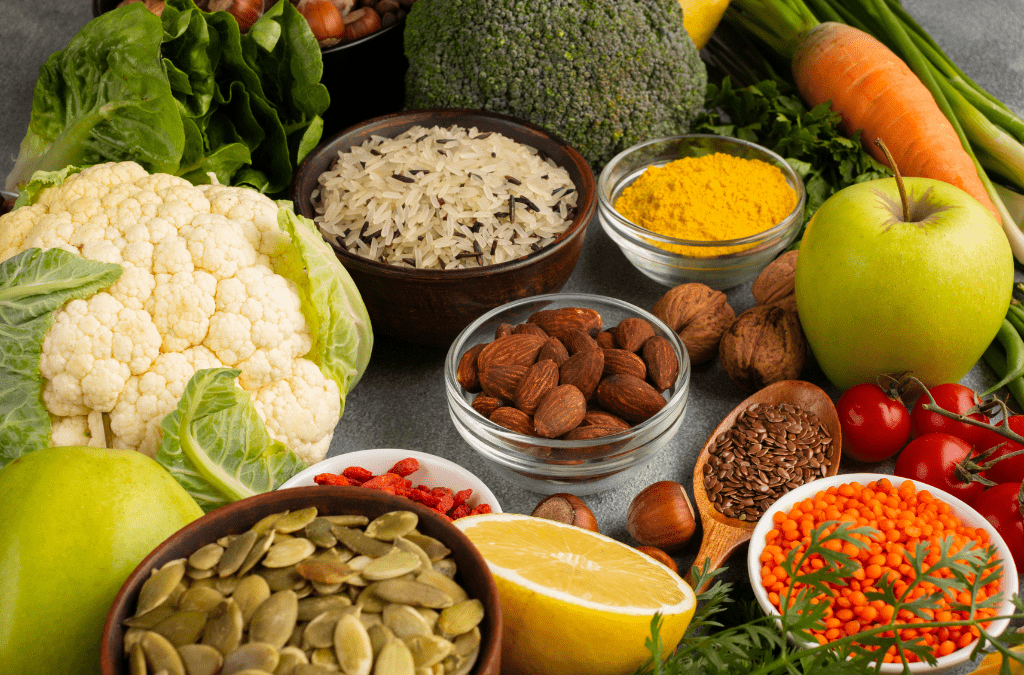
Table of Contents
Introduction
Fiber is an essential nutrient in the diet that plays a critical role in maintaining overall health. It supports digestive health, helps manage weight, promotes heart health, and may reduce the risk of certain types of cancer. It is crucial to prioritize fiber as an essential part of your daily diet for optimal health and well-being.
Types of Fiber
Fiber, also known as dietary fiber or roughage, is classified into two main types:
- Soluble Fiber
- Insoluble Fiber
Both types of fiber have unique characteristics and health benefits.
1. Soluble Fiber
Soluble fiber dissolves in water and forms a gel-like substance in the digestive tract. It is found in foods such as oats, barley, legumes, apples, oranges, carrots, and flaxseeds.
2. Insoluble Fiber
Insoluble fiber does not dissolve in water and passes through the digestive tract largely intact. It is found in high-fiber foods such as whole grains, wheat bran, nuts, seeds, and the skins of fruits and vegetables.
Remember that, many plant-based foods contain a combination of soluble and insoluble fiber, and a balanced intake of both types benefits overall health.
There are uncountable benefits to having fiber in your daily diet, right?
The good news is that they are effortlessly available in your routine staple food. You just need to regularly incorporate them into your meals and get the health benefits offered by them.
15 High-Fiber Foods
For your convenience, the 15 high-fiber foods list is classified according to their food groups ahead. So, take full advantage of it and get healthy!
Legumes
1. Lentils
Lentils are a type of legume known for its high fiber content. Lentils come in various colors, including green, brown, red, and black, and they are a common staple ingredient in many cuisines worldwide.
You must be aware of the famous ’Dal’ cooked commonly in South Asian households.
The fiber content in lentils is primarily composed of both soluble and insoluble fiber, providing a combination of health benefits. They are a good source of protein as well. Cooked lentils contain around 13.1 grams of fiber per cup serving.
2. Black Beans
They are an excellent plant-based source of both soluble and insoluble fiber.
The exact amount of fiber in black beans varies depending on the cooking method and serving size, but on average, cooked black beans contain around 7-8 grams of fiber per 1/2 cup serving.
3. Chickpeas
Chickpeas are legumes that are also nutritious and which are high in fiber. They are affordable and can be cooked in numerous different delicious recipes.
Cooked chickpeas contain about 12.5 grams of fiber per cup serving. Chickpeas are ideally recommended as high protein and high-fiber food for weight loss.
Whole Grains
4. Oats
If you are aiming to control your weight, Oats are a perfect grain you should add to your diet. They are food high in fiber that helps you manage your gut health and lower your LDL (bad cholesterol) levels.
You can enjoy oats with milk, or cooked with chicken or meat. There is 16.5 grams of fiber in a cup serving of raw rolled oats, while steel-cut oats may have slightly more fiber content.
5. Quinoa
Quinoa is perceived as a grain, although it is a seed, rich in protein and fiber.
You can enjoy them in different recipes, in burgers, or with your stew. A cup of cooked Quinoa typically contains 5.2 grams of fiber.
6. Barley
Almost everyone consumes barley in their daily diet, in different forms. It is a high-fiber food and one of the most consumed grains all around the world.
It is rich in many beneficial nutrients and contains several vitamins and minerals. 15-17 grams of fiber is present in a half-cup serving of Barley.
Do you know, Barley is one of the most consumed high-fiber foods in India?
Fruits
7. Raspberries
Raspberries are not only one of the tastiest fruits but they are loaded with several vitamins, antioxidants, minerals, and a considerably high-fiber food. You can add them to your fruit salads or can enjoy them with a bowl of yogurt as a refreshing and energy-boosting high-fiber food. 6.5 grams of fiber is present in 100 grams of raspberries.
8. Pears
Pears are quite affordable, tastiest, and a high-fiber food.
A normal medium-sized single pear, if eaten unpeeled, can grant you approximately 5.5 grams of fiber, fulfilling 21% of your recommended daily need for fiber.
Let me tell you an additional benefit, if you are searching for a high in fiber food for constipation, try consuming pears, they are considered a natural laxative, to help you with constipation and gut health.
9. Apple
Apple, a common fruit, is one of the foods high in fiber.
You can have 4.4 grams of fiber in one medium-sized apple. Additionally, it contains a lot more minerals, and nutrients essential for health.
Vegetables
10. Broccoli
Broccoli is rich in antioxidants and rich in fibers also. It contains nutrients that not only support gut health but are crucial for your eyes and healthy cardiac system. It can be consumed in both forms, raw or cooked. A cup size Broccoli contains 2.4 grams of fiber.
11. Brussels Sprouts
Brussels sprouts are high in nutrients, vitamin K, vitamin C, and folate. A cup of Broccoli sprout could give 3.3 grams of fiber.
12. Carrots
Who doesn’t eat carrots?
Wondering, are carrots also a high-fiber food?
The answer is yes. Along with loads of other extremely beneficial nutrients, a half cup of chopped raw crunchy carrots can give you 2.8 grams of fiber.
Nuts and Seeds
13. Chia Seeds
Chia seed is considered a superfood. It is loaded with many nutrients and minerals essential for health. It is one of the foods high in fiber. You can have 30-35 grams of fiber, by consuming half a cup of chia seeds.
14. Almonds
Almond, your most popular and tastiest nut, is one of the foods which is high in fiber.
We all know almonds are rich in nutrients, minerals, healthy fats, and vitamins. It is also a good source of fiber. 3 tbsp of almonds contains 4 grams of fiber.
15. Flaxseeds
Flaxseeds can help you with your weight management. It is helpful to lower the risk of other chronic diseases as well, such as high blood pressure, high cholesterol, and some cancers. 100 grams of flaxseeds are loaded with 27-30 grams of fiber.
This is a chart of high-fiber food to help you manage your daily fiber intake:
No. | Food | Serving | Fiber Content |
1 | Chia Seeds | 2 tablespoons | 10 grams |
2 | Lentils | 1 cup (cooked) | 15.6 grams |
3 | Black Beans | 1 cup (cooked) | 15 grams |
4 | Avocado | 1 medium | 10 grams |
5 | Raspberries | 1 cup | 8 grams |
6 | Artichoke | 1 medium | 10.3 grams |
7 | Broccoli | 1 cup (cooked) | 5.1 grams |
8 | Almonds | 1 cup | 4.5 grams |
9 | Quinoa | 1 cup (cooked) | 5.2 grams |
10 | Whole-wheat Pasta | 1 cup (cooked) | 6.3 grams |
11 | Barley | 1 cup (cooked) | 6 grams |
12 | Chickpeas | 1 cup (cooked) | 12.5 grams |
13 | Pears | 1 medium | 5.5 grams |
14 | Green peas | 1 cup (cooked) | 8.8 grams |
15 | Apples | 1 medium | 4.4 grams |
16 | Brussels Sprouts | 1 cup (cooked) | 4 grams |
17 | Flaxseeds | 2 tablespoons | 5.6 grams |
18 | Oatmeal | 1 cup (cooked) | 4 grams |
19 | Kidney Beans | 1 cup (cooked) | 11.3 grams |
20 | Spinach | 1 cup (cooked) | 4.3 grams |
Conclusion
Fiber is an important nutrient in the diet that plays a critical role in maintaining overall health. Including a variety of fiber-rich foods in your diet can have a positive impact on your well-being and contribute to a healthy lifestyle.
FAQs
Ans. There are numerous benefits of incorporating foods that are high in fiber into your daily diet.
- Digestive Health: Fibers act as probiotics, to promote a healthy gut and support maintaining your healthy digestive system. Insoluble fiber adds bulk to stools, which can help promote regular bowel movements and prevent constipation. It can also help maintain a healthy colon.
- Heart Health: Fiber has been shown to help lower LDL cholesterol levels supporting cardiac health, by binding to cholesterol in the gut and preventing its absorption into the bloodstream.
- Blood Sugar Management: Fiber can slow down sugar absorption, helping regulate blood sugar levels.
- Weight Management: Insoluble fiber is generally lower in calories and can help with weight management by providing a feeling of fullness, which can reduce hunger and prevent overeating.
Ans. According to expert’s recommendations, a woman should intake 25 grams, while a man should take 38 grams of fiber in a day.
Ans. If you consume a lot more than the recommended amount of fiber, you can have bloating, stomach cramps, and flatulence.
Ans. Try incorporating recommended high fiber food in your salads, and daily meals. Always eat the recommended portion of fruits and vegetables with your meal, to meet the daily fiber demand of your body.







